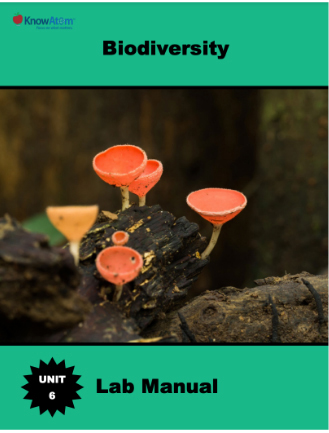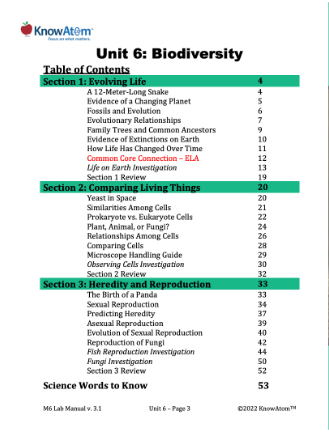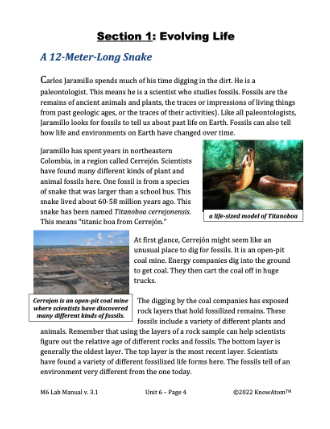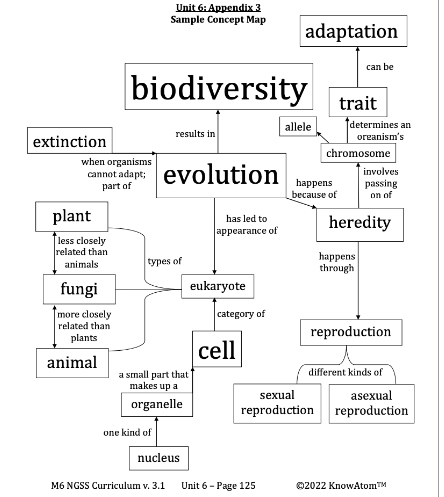Science background provides teachers with more in-depth information on the phenomena students explore in this unit. Below is an excerpt of the science background section from this lesson on life on Earth.
Evolution
Evolution describes the changes in the heritable traits of a population of organisms as successive generations replace one another. Broadly speaking, the theory of evolution says that all life on Earth descended from a common ancestor. Over the billions of years since life first appeared on Earth, scientists believe that evolution has caused the tremendous diversity of life forms around us today. Over many generations as organisms reproduced and had offspring, different kinds of organisms evolved, each with a unique set of traits that help it survive in its environment.
It’s important to take a moment to define theory in the scientific context. When scientists refer to a theory such as the theory of evolution, they are referring to an explanation about the natural world that is supported by numerous data and has been repeatedly tested and confirmed. In this sense then, evolution is widely agreed upon within the scientific community, even though it remains controversial among some other communities. Here we are presenting some of the scientific evidence that supports evolution.
Evidence for Evolution
Much of the scientific evidence for evolution comes from the fossil record, which includes all of the fossils that have ever been found on Earth. Scientists look for patterns in the different fossils to draw conclusions about how life has evolved and changed over time. For scientists who study evolutionary relationships, a key to understanding how different organisms relate to one another is to look for similarities rather than differences. This is because these similarities tell of a shared background.
Heredity and Reproduction
Traits are determined by an organism’s genes, which are units of heredity. Each gene contains a specific structure of a molecule called DNA that provides instructions for how to make one or a few related proteins. Different combinations of proteins determine an organism’s traits. Everything that takes place in an organism is either made of proteins or is the result of an action caused by a protein.
When adult organisms have offspring, they pass along their genetic information—and therefore traits—to their offspring. However, there is variation among the offspring. This means that not all offspring have identical traits to each other or to their parents. Genetic variation can happen for several reasons. One is mutations, which are permanent changes to an organism’s DNA, which can cause changes in traits. For example, scientists believe that blue eyes in humans are a result of a genetic mutation. Another source of genetic variation is sexual reproduction, which we’ll explore a little later on.
Natural Selection
Because offspring have variations in traits, some individuals have traits that are better suited to their environment than others. These traits that help an organism survive in its environment are called adaptations. Those individuals are more likely to survive and reproduce themselves, passing along their adaptations to offspring.
Over many generations, the advantages that had started out in just a few organisms become more widespread because more organisms with those advantages survive and reproduce. This is called natural selection—the theory that organisms well fitted to their environments will have offspring and pass on useful adaptations. Those organisms that cannot adapt to their environment don’t reproduce and die out over time.
Natural selection is one cause of evolution. It can result in new species when one population of organisms gets separated from each other. A species is a group of genetically similar organisms. For example, humans are a species, as are snakes and baker’s yeast. Let’s think about that ancient snake that was found. Scientists are still looking for answers to its evolution, but we infer certain things.
For example, we know that in the last 60 million years, Earth’s climate has changed significantly. Cerrejón is no longer a tropical rainforest, and it is cooler than scientists believe it used to be. As these climate changes occurred, some snakes were likely better adapted to the cooler, drier climate. Some snakes were probably a little smaller than others, and those smaller snakes might have been better suited to the cooler environment.
As a result, they were more likely to survive and reproduce, passing along their smaller size to their offspring. Over time, the entire population of snakes might have become smaller because the larger snakes would have died off before reproducing. Over millions of years, the new species of snake might have continued to evolve until it developed into the modern boa constrictor.
This is a simplified prediction about the evolution of boa constrictors. The interactions between an organism’s traits, the environment, and its ability to survive can be complex. However, we know that these modern boas are different enough from the ancient Titanoboa that they are considered a different species. However, because they descended from Titanoboa, they are related to it.
Scientists believe that a similar process has occurred among all living things. This means that all living things are related to one another in some way. Some are more distantly related than others, depending on how long ago they evolved apart to form new species. Scientists use a “family tree” to show these evolutionary relationships.
Common Ancestors
Comparing the anatomical structures of ancient fossils to other ancient fossils and to the body structures of modern organisms is one way that scientists can determine where an organism fits on the evolutionary tree. However, this is an ongoing process because the fossil record provides an incomplete picture of all life that has ever existed. In addition to finding mostly fragments, very few organisms that have ever existed are turned into fossils. This means scientists have to make inferences based on what they know and can observe.
For example, when the scientists in Cerrejón found a skull belonging to a set of fossilized snake vertebrae, they were excited because it provided them with an additional structure to compare to other snakes to see how it is related. The evolutionary family tree also shows how most living things that once lived are now extinct. Extinction happens when a species no longer has living members in existence. Scientists believe that more than 90 percent of all organisms that have ever existed are now extinct, including Titanoboa.
Extinctions
There are two broad kinds of extinctions. One is called background extinction or normal extinction, and it refers to a gradual process that results in one or a few species becoming extinct at a time. A sudden change to the environment, such as a drought, flood, or introduction of a new species can cause those species that are unable to adapt to become extinct.
Mass extinction is the other kind of extinction, and it happens when the majority of all species on Earth become extinct in a geologically short period of time. Scientists believe that there have been five major mass extinctions since life first formed, based on evidence in the fossil record. Evidence for a mass extinction in the fossil record includes a lower, older layer of rock with a lot of biodiversity of fossils, and the younger layer directly above with very little biodiversity. Biodiversity is the variety of life forms in the world or in a particular ecosystem.
Scientists believe that each mass extinction was caused by a significant event or series of events that caused Earth’s environment to change dramatically and quickly. For example, a mass extinction occurred 248 million years ago that has been nicknamed “the Great Dying” because 96 percent of all species died out. This means that all of life on Earth today has evolved from the 4 percent of species that survived. Scientists still don’t know what caused that mass extinction, but they believe it was complex and likely had multiple causes.
Perhaps the most well-known mass extinction is also the most recent, occurring 66 million years ago. It wiped out 75 percent of all plant and animal life, including all non-avian dinosaurs. Evidence for this extinction can be read in rock layers, specifically in a thin layer of sediment that is found around the world in both marine and land rocks. This layer has high levels of a metal called iridium, which is rare in Earth’s crust but plentiful in asteroids. For this reason, many scientists believe that an asteroid crashing into Earth is the most likely cause of this mass extinction. However, there remains some debate, with some scientists believing other causes might be volcanic eruptions, climate change, or sea level change.








